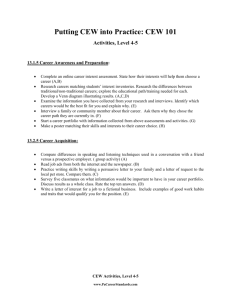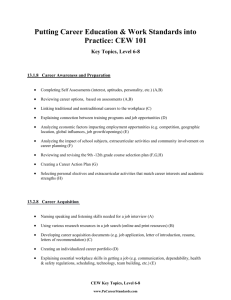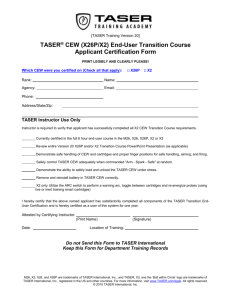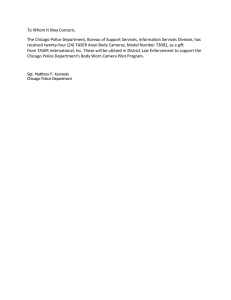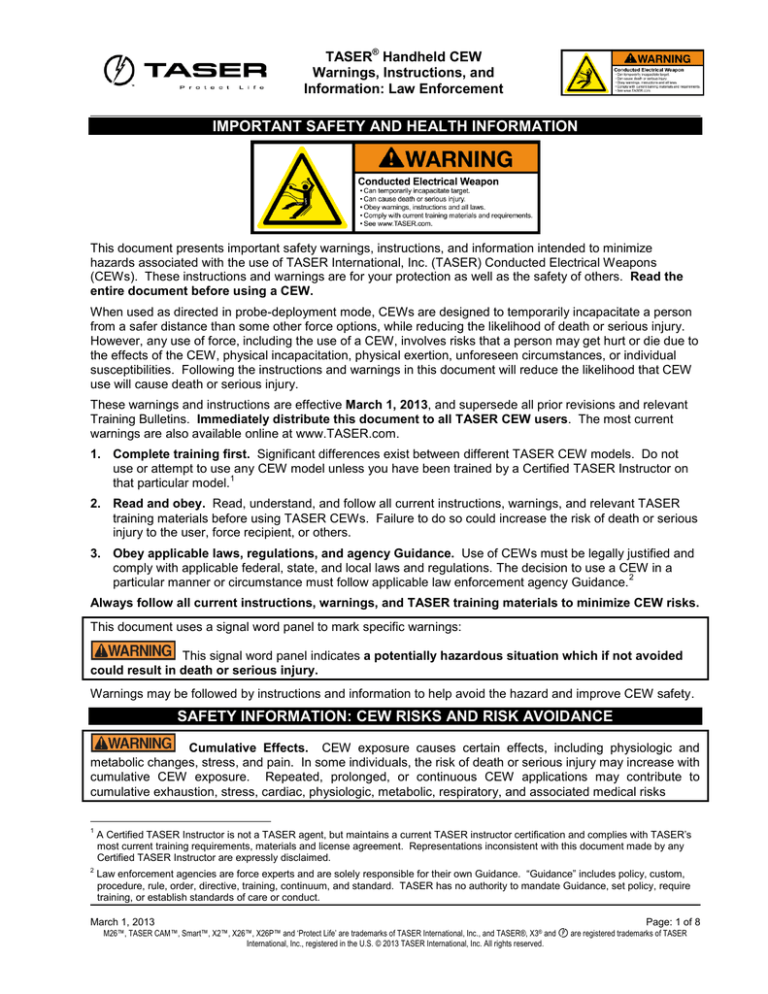
TASER® Handheld CEW
Warnings, Instructions, and
Information: Law Enforcement
IMPORTANT SAFETY AND HEALTH INFORMATION
This document presents important safety warnings, instructions, and information intended to minimize
hazards associated with the use of TASER International, Inc. (TASER) Conducted Electrical Weapons
(CEWs). These instructions and warnings are for your protection as well as the safety of others. Read the
entire document before using a CEW.
When used as directed in probe-deployment mode, CEWs are designed to temporarily incapacitate a person
from a safer distance than some other force options, while reducing the likelihood of death or serious injury.
However, any use of force, including the use of a CEW, involves risks that a person may get hurt or die due to
the effects of the CEW, physical incapacitation, physical exertion, unforeseen circumstances, or individual
susceptibilities. Following the instructions and warnings in this document will reduce the likelihood that CEW
use will cause death or serious injury.
These warnings and instructions are effective March 1, 2013, and supersede all prior revisions and relevant
Training Bulletins. Immediately distribute this document to all TASER CEW users. The most current
warnings are also available online at www.TASER.com.
1. Complete training first. Significant differences exist between different TASER CEW models. Do not
use or attempt to use any CEW model unless you have been trained by a Certified TASER Instructor on
1
that particular model.
2. Read and obey. Read, understand, and follow all current instructions, warnings, and relevant TASER
training materials before using TASER CEWs. Failure to do so could increase the risk of death or serious
injury to the user, force recipient, or others.
3. Obey applicable laws, regulations, and agency Guidance. Use of CEWs must be legally justified and
comply with applicable federal, state, and local laws and regulations. The decision to use a CEW in a
2
particular manner or circumstance must follow applicable law enforcement agency Guidance.
Always follow all current instructions, warnings, and TASER training materials to minimize CEW risks.
This document uses a signal word panel to mark specific warnings:
This signal word panel indicates a potentially hazardous situation which if not avoided
could result in death or serious injury.
Warnings may be followed by instructions and information to help avoid the hazard and improve CEW safety.
SAFETY INFORMATION: CEW RISKS AND RISK AVOIDANCE
Cumulative Effects. CEW exposure causes certain effects, including physiologic and
metabolic changes, stress, and pain. In some individuals, the risk of death or serious injury may increase with
cumulative CEW exposure. Repeated, prolonged, or continuous CEW applications may contribute to
cumulative exhaustion, stress, cardiac, physiologic, metabolic, respiratory, and associated medical risks
1
A Certified TASER Instructor is not a TASER agent, but maintains a current TASER instructor certification and complies with TASER’s
most current training requirements, materials and license agreement. Representations inconsistent with this document made by any
Certified TASER Instructor are expressly disclaimed.
2
Law enforcement agencies are force experts and are solely responsible for their own Guidance. “Guidance” includes policy, custom,
procedure, rule, order, directive, training, continuum, and standard. TASER has no authority to mandate Guidance, set policy, require
training, or establish standards of care or conduct.
March 1, 2013
Page: 1 of 8
M26™, TASER CAM™, Smart™, X2™, X26™, X26P™ and ‘Protect Life’ are trademarks of TASER International, Inc., and TASER®, X3® and © are registered trademarks of TASER
International, Inc., registered in the U.S. © 2013 TASER International, Inc. All rights reserved.
TASER® Handheld CEW
Warnings, Instructions, and
Information: Law Enforcement
which could increase the risk of death or serious injury. Minimize repeated, continuous, or simultaneous
exposures.
Physiologic and Metabolic Effects. CEW use causes physiologic and/or metabolic effects that may
increase the risk of death or serious injury. These effects include changes in blood chemistry, blood pressure,
respiration, heart rate and rhythm, and adrenaline and stress hormones, among others. In human studies of
electrical discharge from a single CEW of up to 15 seconds, the effects on acid/base balance, creatine
kinase, electrolytes, stress hormones, and vital signs were comparable to or less than changes expected from
physical exertion similar to struggling, resistance, fighting, fleeing, or from the application of some other force
tools or techniques.
Some individuals may be particularly susceptible to the effects of CEW use. These susceptible individuals
include the elderly, those with heart conditions, asthma or other pulmonary conditions, and people suffering
from excited delirium, profound agitation, severe exhaustion, drug intoxication or chronic drug abuse, and/or
over-exertion from physical struggle. In a physiologically or metabolically compromised person, any
physiologic or metabolic change may cause or contribute to sudden death.
Stress and Pain. CEW use, anticipation of use, or response to use can cause startle, panic, fear, anger,
rage, temporary discomfort, pain, or stress which may be injurious or fatal to some people.
To reduce the risk from CEW exposure:
1. Minimize the number and duration of CEW exposures. Most human CEW lab testing has not
exceeded 15 seconds of CEW application, and none has exceeded 45 seconds. Use the shortest
duration of CEW exposure objectively reasonable to accomplish lawful objectives, and reassess the
subject’s behavior, reaction, and resistance before initiating or continuing the exposure. If a CEW
deployment is ineffective in incapacitating a subject or achieving compliance consider alternative control
measures in conjunction with or separate from the CEW.
2. Avoid simultaneous CEW exposures. Do not use multiple CEWs or multiple completed circuits at the
same time without justification. Multiple CEWs or multiple completed circuits at the same time could have
cumulative effects and result in increased risks.
3. Control and restrain immediately. Begin control and restraint procedures, including during CEW
exposure (“cuffing under power”), as soon as reasonably safe and practical to minimize CEW cumulative
effects and the total duration of exertion and stress experienced by the subject.
4. Avoid touching probes/wires during CEW discharge. Controlling and restraining a subject during
CEW exposure may put the CEW user and those assisting at risk of accidental or unintended shock.
Avoid touching the probes and wires and the areas between the probes during the electrical discharge.
Cardiac Capture. CEW exposure in the chest area near the heart has a low probability of
inducing extra heart beats (cardiac capture). In rare circumstances, cardiac capture could lead to cardiac
arrest. When possible, avoid targeting the frontal chest area near the heart to reduce the risk of potential
serious injury or death.
Cardiac capture may be more likely in children and thin adults because the heart is usually closer to the
CEW-delivered discharge (the dart-to-heart distance). Serious complications could also arise in those with
impaired heart function or in those with an implanted cardiac pacemaker or defibrillator.
March 1, 2013
Page: 2 of 8
M26™, TASER CAM™, Smart™, X2™, X26™, X26P™ and ‘Protect Life’ are trademarks of TASER International, Inc., and TASER®, X3® and © are registered trademarks of TASER
International, Inc., registered in the U.S. © 2013 TASER International, Inc. All rights reserved.
TASER® Handheld CEW
Warnings, Instructions, and
Information: Law Enforcement
To reduce the risk of injury:
1. Use preferred target areas. The preferred target areas (blue) are below the neck
area for back shots and the lower center mass (below chest) for front shots. The
preferred target areas increase dart-to-heart distance and reduce cardiac risks. Back
shots are preferable to front shots when practicable.
2. Avoid sensitive areas. When practicable, avoid intentionally targeting the CEW on
sensitive areas of the body such as the face, eyes, head, throat, chest area (area of
the heart), breast, groin, genitals, or known pre-existing injury areas.
Muscle Contraction or Strain-Related Injury. CEWs in probe-deployment mode can
cause muscle contractions that may result in injury, including bone fractures.
Higher Risk Populations. CEW use on a pregnant, infirm, elderly, or low body-mass index
person or on a small child could increase the risk of death or serious injury. As with any force option, CEW
use has not been scientifically tested on these populations. Use a CEW on such persons only if the situation
justifies an increased risk.
CEWs in probe-deployment mode can cause muscle contractions resulting in injuries similar to those from
physical exertion, athletics, or sports, including hernia rupture, dislocation, tear, or other injury to soft tissue,
organ, muscle, tendon, ligament, cartilage, disc, nerve, bone, or joint; or injury or damage associated with or
to orthopedic or other hardware. Fractures to bone, including compression fracture to vertebrae, may occur.
These injuries may be more serious and more likely to occur in people with pre-existing injuries, orthopedic
hardware, conditions or special susceptibilities, including pregnancy; low bone density; spinal injury; or
previous muscle, disc, ligament, joint, bone, or tendon damage or surgery. Such injuries may also occur in
drive-stun applications or when a person reacts to the CEW deployment by making a rapid or unexpected
movement.
Secondary Injury. The loss of control resulting from a CEW exposure may result in injuries
due to a fall or other uncontrolled movement. When possible, avoid using a CEW when secondary injuries
are likely.
Loss of control associated with CEW use can have several causes:
Seizure. Repetitive stimuli (e.g., flashing light or electrical stimuli) can induce seizure in some people,
which may result in death or serious injury. This risk may be increased in a person with epilepsy, a
seizure history, or if electrical stimuli pass through the head. Emotional stress and physical exertion, both
likely in incidents involving CEW and other uses of force, are reported as seizure-precipitating factors.
Fainting. A person may experience an exaggerated response to a CEW exposure, or threatened
exposure, which may result in fainting or falling.
Muscle contraction, incapacitation, or startle response. CEW use may cause loss of control from
muscle contraction, incapacitation, or startle response.
To reduce these risks, consider the person’s location before using a CEW. When practicable, avoid using a
CEW on a person in the following circumstances unless the situation justifies a higher risk.
When practicable, avoid using a CEW on a person who:
is on an elevated or unstable surface (e.g., tree, roof, ladder, ledge, balcony, porch, bridge, or stair);
could fall and suffer impact injury to the head or other area;
could fall on a sharp object or surface (e.g., holding a knife, falling on glass);
is less able to catch or protect self in a fall (e.g., restrained, handcuffed, incapacitated, or immobilized);
has impaired reflexes (e.g., from alcohol, drugs or certain medications);
is running, in motion, or moving under momentum;
March 1, 2013
Page: 3 of 8
M26™, TASER CAM™, Smart™, X2™, X26™, X26P™ and ‘Protect Life’ are trademarks of TASER International, Inc., and TASER®, X3® and © are registered trademarks of TASER
International, Inc., registered in the U.S. © 2013 TASER International, Inc. All rights reserved.
TASER® Handheld CEW
Warnings, Instructions, and
Information: Law Enforcement
is operating or riding any mode of transportation (e.g., vehicle, bus, bicycle, motorcycle, or train),
conveyance (e.g., escalator, moving walkway, elevator, skateboard, rollerblades), or machinery; or
is located in water, mud, or marsh environment if the ability to move is restricted.
SAFETY INFORMATION: INJURY OR INFECTION
A CEW may cause injury as a result of the probe or electrical discharge. The nature and severity of these
effects depends on numerous factors including the area of exposure, method of application, individual
susceptibility, and other circumstances surrounding CEW use, exposure, and after care. Medical care may
be required.
Eye Injury Hazard. A TASER probe, electrode, or electrical discharge that contacts or
comes close to an eye can result in serious injury, including permanent vision loss. DO NOT intentionally aim
a CEW, including the LASER, at the eye of a person or animal without justification.
LASER Light Hazard. CEWs use a LASER targeting aid. LASERs can cause serious eye injury,
including permanent vision loss. NEVER aim a LASER at an aircraft or the operator of an aircraft or moving
vehicle.
Probe or Electrode Injury, Puncture, Scarring, or Infection Hazard. CEW use may cause
a permanent mark, burn, scar, puncture, or other skin or tissue damage. Infection could result in death or
serious injury. Scarring risk may be increased when using a CEW in drive-stun mode. Increased skin
irritation, abrasion, mark, burning, or scarring may occur with a CEW with multiple cartridge bays when used
in drive-stun or three-point deployment modes.
Penetration Injury. The TASER probe has a small dart point which may cause a
penetration injury to a blood vessel or internal organ, including lung, bone, or nerve. The probe or dart point
(which may detach or break) can puncture or become embedded into a bone, organ, or tissue, which may
require immediate medical care, surgical removal, or may result in scarring, infection, or other serious injury.
To reduce the risk of serious or permanent injury:
1. Provide medical care as needed. Injury due to penetration of a probe or dart point into a blood vessel,
organ, nerve, or bone may require medical care. A probe, dart point, or barb embedded in a sensitive
area such as the eye, genitals, breast, neck, throat, or vascular structure may cause serious injury and
require medical care. CEW use may cause skin irritation, puncture wound, abrasion, mark, rash, burn, or
other scar or infection, which may require medical care and may be permanent. As with any injury of this
type, infection or tetanus and resulting complications may occur. In accordance with your agency’s
Guidance, ensure access to medical care if needed.
2. Follow agency Guidance for removing probes. Probe removal may cause injury. Leaving a probe in
the body may result in pain or injury. Follow your agency’s Guidance and biohazard protocols for probe
removal. In the case of embedment, organ or bone penetration, or probe, dart point, or barb detachment,
immediate medical care and possible surgical removal may be required.
3. Follow biohazard protocols. Use appropriate biohazard protocols including isolation procedures and
protective equipment (e.g., gloves, masks, and washing of hands and exposed areas as necessary).
Follow your agency’s Guidance and appropriate biohazard, waste, and evidence protocols when dealing
with biohazards.
SAFETY INFORMATION: CEW DEPLOYMENT AND USE
CEWs and cartridges are weapons and as with any weapon follow safe weapon-handling
practices and store your CEW securely. Follow practices herein and additional requirements in your agency’s
Guidance. Failure to follow these warnings may result in death or serious injury to the user or others.
March 1, 2013
Page: 4 of 8
M26™, TASER CAM™, Smart™, X2™, X26™, X26P™ and ‘Protect Life’ are trademarks of TASER International, Inc., and TASER®, X3® and © are registered trademarks of TASER
International, Inc., registered in the U.S. © 2013 TASER International, Inc. All rights reserved.
TASER® Handheld CEW
Warnings, Instructions, and
Information: Law Enforcement
Confusing Handgun with CEW. Confusing a handgun with a CEW could result in death or
serious injury. Learn the differences in the physical feel and holstering characteristics between your CEW
and your handgun to help avoid confusion. Always follow your agency’s Guidance and training.
Trigger Hold-Back Model Differences. If the trigger is held back, most CEWs will continue
to discharge until the trigger is released or the power source is expended. With an APPM installed, the X2
and X26P can be programmed to stop a CEW discharge at 5 seconds even if the user continues to hold back
the trigger, requiring a deliberate action to re-energize the deployed cartridge. Know your model and how it
works. Avoid repeated, prolonged, or continuous CEW applications when practicable.
In stressful or noisy circumstances, the APPM’s audible warning may not be heard.
1. Use properly. Use a CEW only for its intended purpose, in legally justifiable situations, and in
accordance with your agency’s Guidance. Do not use for torture.
2. Store in a secure location. Store CEWs, cartridges, and accessories in secure locations inaccessible to
children and other unauthorized persons to prevent inappropriate access or use.
3. Use the safety switch. Place the CEW safety switch in the down (SAFE) position when the CEW is not
in use. Remember to place the CEW safety switch in the up (ARMED) position when you intend to use
the CEW.
4. Assume CEW is loaded. Always assume that a CEW is loaded and capable of discharging. To help
avoid unexpected discharge, ensure that no live cartridge is in the CEW when inserting a battery pack;
TASER CAM™ or TASER CAM HD recorder; or while performing spark tests (except when function
testing the X2 or X3), maintenance, data downloading, or battery charging.
5. Be aware of CEW trigger. Keep your finger off the trigger until it is legally justifiable to use the CEW and
you are ready to deploy.
6. Know how the CEW works. Significant differences exist between different TASER CEW models.
Before using any CEW, including a multi-shot CEW, ensure you understand the functioning and effects of
that model.
7. Be aware of X2 and X3 deployment mode. Be aware of which deployment mode (manual or semiautomatic) is set on the X2 and X3 before use.
8. Be Aware of X2 Static (Fixed) LASER Sight Mode. The X2 has static dual LASERs. One LASER is
intended to approximately align with the top dart and the other with the bottom dart, both of which are setup for 15′ (4.6 meters (m)) and 25′ (7.62 m) cartridges at a 15′ distance from the target. The trajectory of
the 35′ (10.7 m) long range cartridge will not line up with the bottom LASER when placed in the X2.
9. Use simulation (training) cartridges ONLY for training or practice. DO NOT use a CEW loaded with
a simulation training cartridge for field use or self-defense. Simulation cartridges are intended for practice
only and will have no incapacitating effect on a subject. Simulation cartridges use non-conductive wires
and will not transmit electrical pulses to the probes.
SAFETY INFORMATION: CEW EFFECTIVENESS
A CEW, like any weapon or force option, does not always function as intended and is not effective on every
subject. As with any use of force, if a particular option is not effective, consider using other force options,
disengaging, or using other alternatives per agency Guidance. Always have a back-up plan.
Subject Not Incapacitated. An ineffective CEW application could increase the risk of death
or serious injury to the user, the subject, or others. If a CEW does not operate as intended or if subject is not
incapacitated, disengage, redeploy the CEW, or use other force options in accordance with agency Guidance.
A CEW’s effects may be limited by many factors, including absence of delivered electrical charge due to
misses, clothing disconnect, intermittent connection, or wire breakage; probe locations or spread; subject’s
March 1, 2013
Page: 5 of 8
M26™, TASER CAM™, Smart™, X2™, X26™, X26P™ and ‘Protect Life’ are trademarks of TASER International, Inc., and TASER®, X3® and © are registered trademarks of TASER
International, Inc., registered in the U.S. © 2013 TASER International, Inc. All rights reserved.
TASER® Handheld CEW
Warnings, Instructions, and
Information: Law Enforcement
muscle mass; or movement. Some of the factors that may influence the effectiveness of CEW use in
effecting or achieving control of a subject include:
Subject may not be fully incapacitated. Even though a subject may be affected by a CEW in one part
of his body, the subject may maintain full muscle control of other portions of his body. Control and
restrain a subject as soon as possible, and be prepared in case the subject is not fully incapacitated.
Subject may recover immediately. A subject receiving a CEW discharge may immediately regain
physical or cognitive abilities upon cessation of the delivered CEW discharge. Control and restrain a
subject as soon as possible, and be prepared in case the subject immediately recovers.
Drive-stun mode is for pain compliance only. The use of a handheld CEW in drive-stun mode is
painful, but generally does not cause incapacitation. Drive-stun use may not be effective on emotionally
disturbed persons or others who may not respond to pain due to a mind-body disconnect. Avoid using
repeated drive-stuns on such individuals if compliance is not achieved.
Probes may deviate. CEWs are not precision-aimed weapons. Probe discharge, flight trajectory, and
impact location can be affected by numerous factors, including cartridge or probe accuracy; failure of
cartridge to properly deploy; strong air movements; user and subject movements; or probe striking
subject, clothing, or object with insufficient force or trajectory to penetrate or adhere to subject.
Deviations can result in limited or lack of effectiveness due to misses, failure to complete or maintain the
electrical circuit, a small probe spread, or failure to deliver a sufficient charge to the subject.
CEW or cartridge may fail to fire or operate. No weapon system, force option, or CEW is always
operational or effective. If a CEW, cartridge, or accessory is inoperable or fails to function, consider
reloading and redeploying, using other force options, disengaging, or using other alternatives per agency
Guidance.
SAFETY INFORMATION: OTHER HAZARDS
Probe Recoil or Ricochet. If your target is farther away than the length of the probe wire, or
if one or more probes miss the target, the probe can recoil and bounce back to strike the user or a bystander,
causing injury. Probe recoil is more likely with simulation cartridges because of the nylon probe wire used.
Always be sure your target is within range. Wear protective eyewear when deploying any CEW in training or
for practice. Be sure practice targets have a firm backing that will allow the probes to stick and not bounce off
and strike an unintended person, animal, or object, or continue through the backing and strike objects behind
the target.
Untethered Discharged Probe. A discharged probe that does not impact a subject or target
may become untethered from the wire and travel a significant distance causing serious injury. Always be sure
your target is within range.
Fire and Explosion Hazard. CEW use can result in a fire or explosion when flammable
gases, fumes, vapors, liquids, or materials are present. Use of a CEW in presence of fire or explosion hazard
could result in death or serious injury. When possible, avoid using a CEW in known flammable hazard
conditions.
A CEW can ignite explosive or flammable clothing or materials, liquids, fumes, gases, or vapors (e.g.,
gasoline, vapor or gas found in sewer lines or methamphetamine labs, butane-type lighters, flammable hair
gels or some self-defense sprays). Do not knowingly use a CEW in the presence of any explosive or
flammable substance unless the situation justifies the increased risk.
SAFETY INFORMATION: GENERAL PRECAUTIONS
Unintentional CEW Deployment or Discharge Hazard. Unintentional CEW activation or
unexpected cartridge discharge could result in death or serious injury to the user, subject, or others.
March 1, 2013
Page: 6 of 8
M26™, TASER CAM™, Smart™, X2™, X26™, X26P™ and ‘Protect Life’ are trademarks of TASER International, Inc., and TASER®, X3® and © are registered trademarks of TASER
International, Inc., registered in the U.S. © 2013 TASER International, Inc. All rights reserved.
TASER® Handheld CEW
Warnings, Instructions, and
Information: Law Enforcement
To reduce the risk of unintentional deployment or discharge:
1. Avoid static electricity. Keep cartridge away from sources of static electricity. Static electricity can
cause a CEW or X26, X26P, or M26 cartridge to discharge unexpectedly, possibly resulting in serious
injury.
2. Keep body parts away from front of CEW or cartridge. Always keep your hands and body parts away
from the front of the CEW and cartridge. If the CEW discharges unexpectedly you could be injured.
3. Avoid electronic equipment interference. Electronic transmission equipment close to a CEW could
interfere with the proper CEW operation and cause the CEW to deploy or discharge. Keep the CEW at
least several inches away from other electronic equipment. Place the CEW safety switch in the down
(SAFE) position whenever it is near electronic equipment, including transmitting radios and cell phones.
Remember to place the CEW safety switch in the up (ARMED) position before use.
4. Avoid dropping CEW or cartridge. If a CEW or cartridge is dropped or damaged it may unintentionally
deploy or discharge, become inoperable, or fail to function, making it unsafe for continued use. If a CEW
or cartridge has been dropped or damaged refer to the procedure recommended in the current version of
the TASER Training materials.
SAFETY INFORMATION: MAINTENANCE
Failure to maintain a CEW as instructed may cause the CEW to malfunction or fail to function
optimally, increasing the risk of death or serious injury. Follow recommended maintenance procedures.
To reduce these risks:
1. Safely perform spark (function) test before each shift. Testing helps verify that the CEW is
functioning properly. See the current version of the TASER Training materials for further information on
testing.
2. Avoid using a damaged CEW or cartridge. Do not use a cartridge with a missing blast door unless
facing an immediate threat. CEW repair or modification by an unauthorized person may cause the CEW
to fire or malfunction, will void the warranty, and may put the user or other person at risk of death or
serious injury. Cartridges with blast doors that have been repaired should only be used for training and
not for field use.
3. Update CEW software. Some CEWs have updateable software. Current CEW software may be
obtained by contacting TASER’s Customer Service Department or following instructions at
www.evidence.com or www.TASER.com.
4. Use only TASER-approved components, batteries, accessories, and cartridges. The CEW is a
sophisticated electronic system. For proper function, use only TASER-approved components, batteries,
accessories, and cartridges with your CEW. Use of anything other than TASER-approved components,
batteries, accessories, and cartridges will void the warranty, may cause malfunction, and may put the
user or other person at risk of death or serious injury.
5. Avoid exposure to wet conditions. If the CEW is drenched or immersed in water or other liquid, DO
NOT use or attempt to use the CEW until completing the procedure recommended by the manufacturer.
6. Keep Smart™ cartridge contacts clean. If the contacts on the Smart cartridge or inside the Smart
cartridge bay of the X2 or X3 are not kept clean the CEW may fail to deploy the Smart cartridge.
March 1, 2013
Page: 7 of 8
M26™, TASER CAM™, Smart™, X2™, X26™, X26P™ and ‘Protect Life’ are trademarks of TASER International, Inc., and TASER®, X3® and © are registered trademarks of TASER
International, Inc., registered in the U.S. © 2013 TASER International, Inc. All rights reserved.
TASER® Handheld CEW
Warnings, Instructions, and
Information: Law Enforcement
7. Know CEW and cartridge expected useful life. Under normal storage, handling, and operating
conditions, a CEW and cartridges have a 5-year expected useful life. Use or attempted use of a CEW or
cartridge after its expected useful life may result in malfunctions and lack of effectiveness. Failure to
properly care for and maintain a CEW or cartridge may substantially reduce or eliminate the expected
useful life of the product.
SAFETY INFORMATION: HAZARDOUS SUBSTANCES
Hazardous Substances. The CEW (including the cartridge) has components that contain
chemicals known to the State of California and others to cause cancer and birth defects or other reproductive
harm. Do not disassemble. Refer to your agency’s Guidance for proper handling and disposal.
March 1, 2013
Page: 8 of 8
M26™, TASER CAM™, Smart™, X2™, X26™, X26P™ and ‘Protect Life’ are trademarks of TASER International, Inc., and TASER®, X3® and © are registered trademarks of TASER
International, Inc., registered in the U.S. © 2013 TASER International, Inc. All rights reserved.

